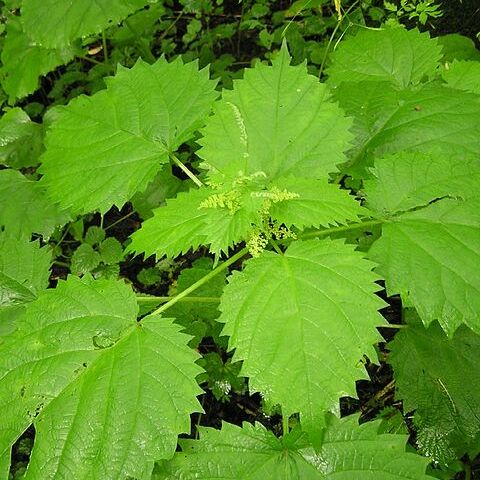Herbs or subshrubs, armed with stinging hairs. Leaves alternate, petiolate; stipules deciduous, intrapetiolar, incompletely connate, apex 2-cleft; leaf blade papery, pinnately veined or 3-veined, margin often coarsely dentate or serrate, rarely entire; cystoliths punctiform or botuliform. Inflorescences solitary, axillary, pedunculate, loose glomerules forming panicles or sometimes racemes or spikes, unisexual (plants monoecious or dioecious); bracts present, very small. Male flowers: perianth lobes 4 or 5, slightly subvalvate, depressed, inflexed in bud; stamens 4 or 5; rudimentary ovary clavate or subglobose. Female flowers: perianth lobes 4, free or connate at base, strongly unequal, dorsal-ventral 2 greatly unequal and smaller, lateral 2 equal and larger; staminodes absent. Ovary at first straight, soon oblique, ovoid; style usually filiform; stigma often linear, at length often reflexed, papillose on 1 side; ovule orthotropous. Achene ovoid to semicircular, often compressed, sessile or stipitate on oblique torus, usually reflexed on dorsiventrally or laterally winged pedicels. Seeds with thin or no endosperm; cotyledons broad.
Herbs , annual or perennial, with stinging and nonstinging hairs on same plant. Stems simple, erect. Leaves alternate; stipules present. Leaf blades narrowly ovate to orbiculate, margins dentate or serrate; cystoliths rounded. Inflorescences axillary and terminal, of paniculately arranged cymes. Flowers unisexual, proximal panicles staminate and distal pistillate, or staminate and pistillate flowers in same panicle; bracts absent. Staminate flowers: tepals 4-5, distinct, equal; stamens 4-5; pistillode knoblike. Pistillate flowers: tepals 2-4, distinct, outer pair minute or absent, without hooked hairs; staminodes absent; style persistent even in fruit, hooklike or elongate; stigma extended along style. Achenes stipitate, laterally compressed, ±orbicular, free from and not enclosed by perianth. x =13.
Herbs or shrubs with irritant (stinging) hairs, monoecious, rarely dioecious. Leaves spirally or alternately arranged, petiolate, simple, chartaceous, variously toothed/dentate; stipules intrapetiolar, partially connate, bifid. Inflorescence axillary, usually paniculate, pedunculate, unisexual or sometimes bisexual; flowers in loose glomerules; pedicels winged. Male flowers: tepals 4 or 5; stamens 4 or 5; filaments reflexed; pistillode small. Female flowers: tepals 4, the dorsiventral ones unequal, smaller than the laterals; staminodes absent; ovary ovoid; style linear, rarely brush-like. Achenes compressed, ovoid to hemispherical, sessile or stipitate, to 4 mm long, with reflexed apex.
Herbs, monoecious, with stinging and/or glandular hairs. Leaves spirally arranged to distichous; stipules connate; blade pinnately veined. Inflorescences bisexual, ± paniculate, with the flowers in loose glomerules. Staminate flowers: tepals (4 or) 5, connate; stamens (4 or) 5. Pistillate flowers: tepals 4, unequal, basally connate; stigma tongue-shaped, persistent on the hooked apex of the fruit. Achene not enclosed by the perianth.
Monoecious; staminate fls with 5 distinct sep and 5 stamens; sep of the pistillate fls 4, the outer pair much smaller, or 3 or 2 by abortion; style elongate, pubescent, persistent; fr an oblique achene, much surpassing the 2 persistent sep; herbs, shrubs, or trees with small fls, often in large clusters. 25, widespread.
Female flowers pedicellate, pedicel sometimes winged; tepals 4, unequal, lateral pair usually much larger than the median pair, and median pair of unequal size; staminodes absent; ovary asymmetrical, ovoid, laterally compressed; stigma sessile, filiform, or deeply trifid with filiform branches.
Achene compressed, often with a characteristic sculpturing on the sides (consisting of an annular ridge enclosing a ± rugose surface), stipitate and shed separately from the persistent perianth (Sect. Laportea), or sessile and shed with the persistent perianth (Sect. Fleurya).
Inflorescences mostly unisexual (occasionally a few flowers of opposite sex intermixed), paniculate, sometimes apparently spicate due to reduction of branches, sometimes appearing as interrupted spikes due to elongation of some internodes.
Annual or perennial herbs (shrubs outside the Flora Zambesiaca area), monoecious or dioecious with numerous stinging hairs (the hairs sometimes mounted on epidermal protuberances).
Male flowers usually pedicellate, regular, 4–5-merous, stamens equalling tepals in number, rudimentary ovary present.
Stipules intrapetiolar, fused almost to the apex.
Leaves alternate, petiolate, simple, serrate.
Cystoliths linear or punctiform.

